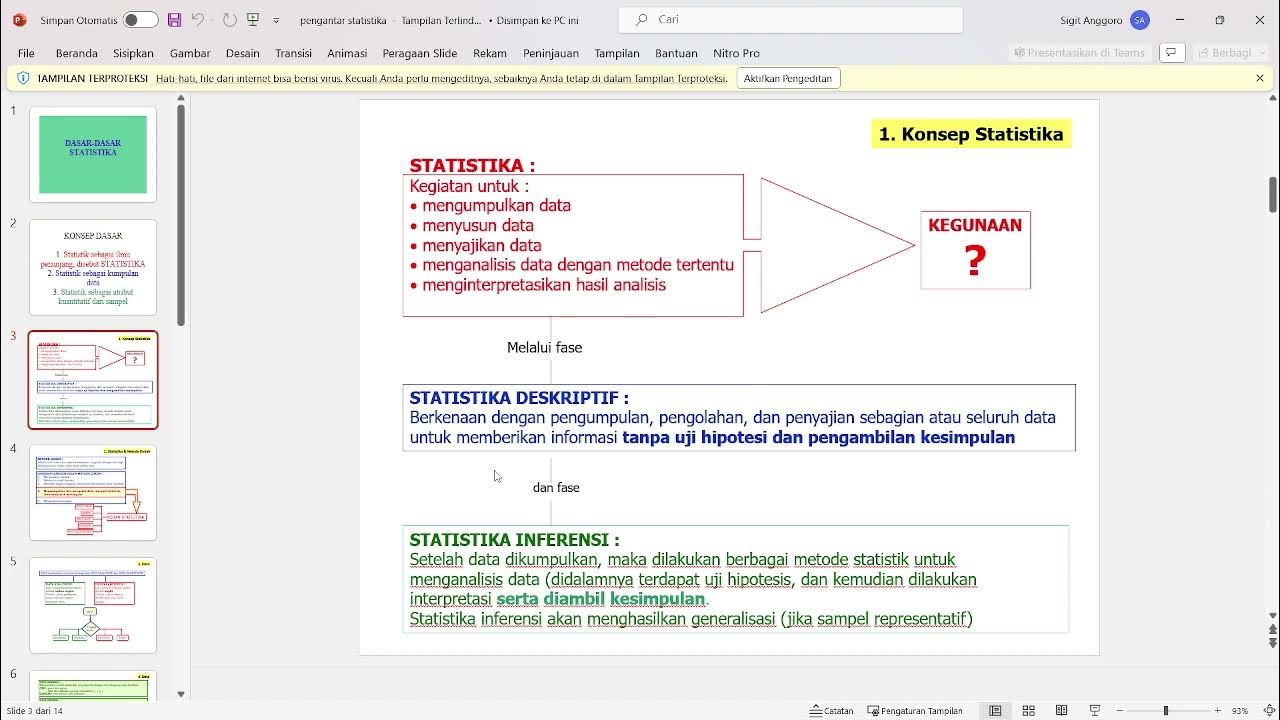STATISTIKA | KONSEP SINGKAT ESTIMASI PARAMETER
Summary
TLDRThis video explores the concept of estimation in statistics, highlighting the need for sampling due to the impracticality of measuring entire populations. It distinguishes between parameters (population characteristics) and statistics (sample characteristics) and introduces inferential statistics for generalizing sample results to populations. Key features of good estimators are discussed, including unbiasedness, efficiency, and consistency. The video also covers point and interval estimation, emphasizing the importance of confidence intervals. With practical insights and clear explanations, viewers are prepared for more in-depth case studies in future sessions.
Takeaways
- 📊 Estimation is crucial in statistics as it allows researchers to infer population parameters from sample data.
- 📉 Due to practical limitations, measuring an entire population is often impossible, necessitating the use of sampling methods.
- 🔍 A sample should ideally represent the population to ensure accurate inference about population parameters.
- 🧮 Inferential statistics involve generalizing findings from a sample to the larger population based on calculated sample statistics.
- 📏 Parameters such as mean, standard deviation, and proportion characterize populations but are often unknown and abstract.
- 📈 Estimators must be unbiased (expected value equals the parameter), efficient (smallest variance), and consistent (converging to the true value with larger samples).
- ⚖️ Point estimation gives a single value estimate of a parameter but lacks the confidence provided by interval estimation.
- ⏳ Interval estimation offers a range of values where the parameter likely falls, increasing the reliability of the estimate.
- 🔗 Understanding sampling distributions is fundamental for effective estimation in statistics.
- 📚 Future videos will cover practical case studies and examples of mean and proportion estimation.
Q & A
What is the main topic discussed in the video?
-The video discusses the concept of estimation in statistics, specifically focusing on parameters and sampling.
What are the parameters mentioned in the script?
-The parameters mentioned include the mean (μ), standard deviation (σ), and proportion (P).
Why is sampling necessary in research?
-Sampling is necessary because it's often impractical to study the entire population due to time and cost constraints.
What is inferential statistics?
-Inferential statistics involves making conclusions about a population based on the analysis of a sample.
What are the two methods to gain information about population parameters?
-The two methods are estimation and hypothesis testing.
What are the three characteristics of a good estimator?
-A good estimator is unbiased, efficient, and consistent.
What does it mean for an estimator to be unbiased?
-An unbiased estimator has an expected value equal to the true parameter value it estimates.
How is the efficiency of an estimator determined?
-The efficiency of an estimator is determined by its variance; a more efficient estimator has a smaller variance.
What is the difference between point estimation and interval estimation?
-Point estimation provides a single value estimate of a parameter, while interval estimation gives a range within which the parameter is expected to lie, along with a confidence level.
What statistical distributions are referenced for sampling?
-The video mentions the normal distribution for large samples and the t-distribution for small samples.
Outlines

This section is available to paid users only. Please upgrade to access this part.
Upgrade NowMindmap

This section is available to paid users only. Please upgrade to access this part.
Upgrade NowKeywords

This section is available to paid users only. Please upgrade to access this part.
Upgrade NowHighlights

This section is available to paid users only. Please upgrade to access this part.
Upgrade NowTranscripts

This section is available to paid users only. Please upgrade to access this part.
Upgrade Now5.0 / 5 (0 votes)





